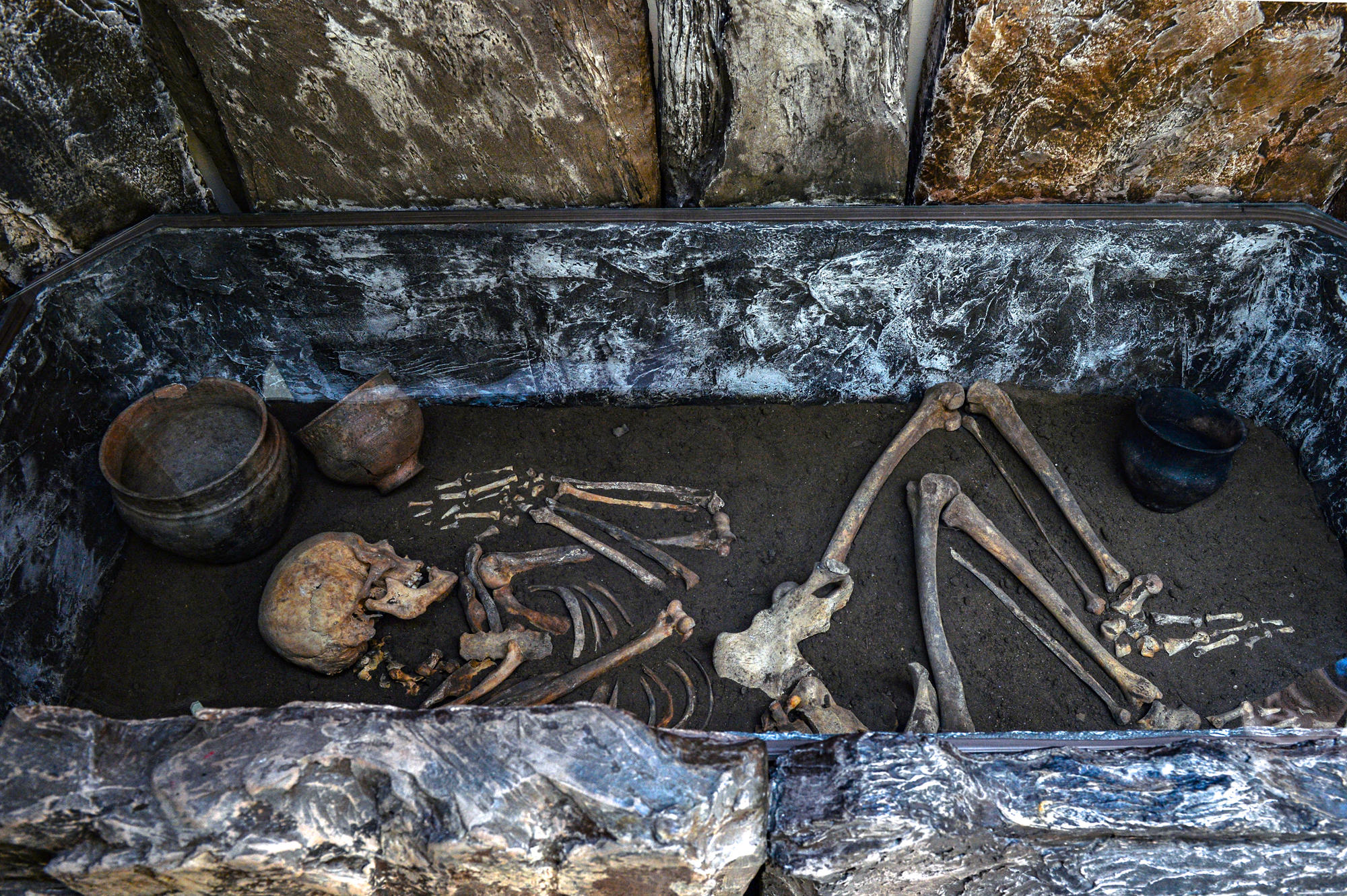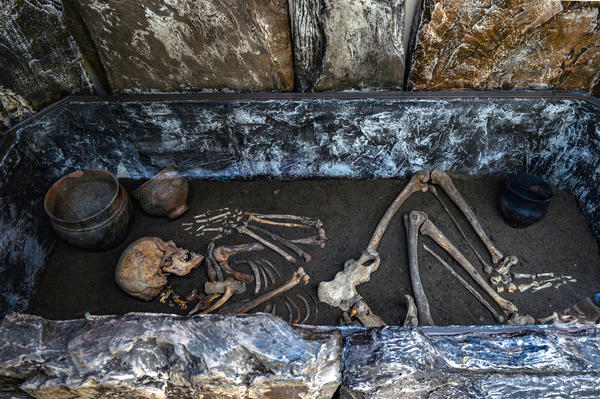The museum’s collection contains a very unusual exhibit - a burial. A significant proportion of the burial mounds in the Novo-Kumakskiy burial ground were established in the second half of 2nd Millennium BC by the Alakulskiy people. One of the characteristics of these people was the use of stone for burial chambers and tombstones. In accordance with Alakul traditions, pits were dug for burial, covered and shut off by stone slabs, in so doing, constructing a sort of stone chamber. For the tombstones, either stone slabs were laid out in a circle, or a round stone structure was built. Chunks or mounds of earth were place around the structure to keep it secure. These mounds were used multiple times. The main burial would be in the center. It would be surrounded by a stone circle. As necessary, other bodies would be buried on the periphery of the ring surrounding the central burial.
The deceased were buried ritually, with the body doubled up (the adoration pose) and most often on its left side. There are a few explanations for this. For a long time it was explained by the fact that people viewed death as being similar to sleep. People commonly sleep in this position. According to Elena Efimovna Kuzmina, comparisons can be drawn between Alakul burial sites and descriptions of burials in Vedic texts, where it is written that the deceased is restored to new life. This signifies that the doubled-up pose is the pose of a child in their mother’s womb. Today, many specialists share the opinion that this is a pose of worship (adoration) for a God. To keep the deceased in the necessary pose, they were tied up.
Generally bodies were buried individually, but experts have come across buried pairs or two adults and a child. If bodies were buried together, it would most often be a man and woman. They lie next to each other. Kuzmina sees this as a very early reflection of Indo-Iranian sati, where the woman voluntarily sacrifices herself after the death of her husband.
Believing in life beyond the grave, the Alakuls placed items next to the deceased which helped the transition to the after world. Most commonly they placed two or three jars by the deceased head. Specialists reckon that they contained food for the deceased.
Elena Efimovna Kuzmina thinks that, just like the ancient Arias, sacrifices were made not only and even not so much to the deceased person, but actually to all who have previously passed away, with the King of the Netherworld at the top. Their numerous exhortations (adoration pose) allows the deceased to fly to the ground, sit on laid out straw and taste the food prepared for them. At the same time, it served as a reminder to never forget to thank the benefactor, by sending them cattle and healthy offspring as a reward.
The deceased were buried ritually, with the body doubled up (the adoration pose) and most often on its left side. There are a few explanations for this. For a long time it was explained by the fact that people viewed death as being similar to sleep. People commonly sleep in this position. According to Elena Efimovna Kuzmina, comparisons can be drawn between Alakul burial sites and descriptions of burials in Vedic texts, where it is written that the deceased is restored to new life. This signifies that the doubled-up pose is the pose of a child in their mother’s womb. Today, many specialists share the opinion that this is a pose of worship (adoration) for a God. To keep the deceased in the necessary pose, they were tied up.
Generally bodies were buried individually, but experts have come across buried pairs or two adults and a child. If bodies were buried together, it would most often be a man and woman. They lie next to each other. Kuzmina sees this as a very early reflection of Indo-Iranian sati, where the woman voluntarily sacrifices herself after the death of her husband.
Believing in life beyond the grave, the Alakuls placed items next to the deceased which helped the transition to the after world. Most commonly they placed two or three jars by the deceased head. Specialists reckon that they contained food for the deceased.
Elena Efimovna Kuzmina thinks that, just like the ancient Arias, sacrifices were made not only and even not so much to the deceased person, but actually to all who have previously passed away, with the King of the Netherworld at the top. Their numerous exhortations (adoration pose) allows the deceased to fly to the ground, sit on laid out straw and taste the food prepared for them. At the same time, it served as a reminder to never forget to thank the benefactor, by sending them cattle and healthy offspring as a reward.



